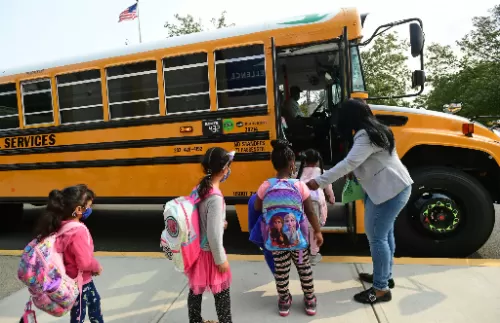
Digital Literacy Lessons for Elementary Students: Teaching Tomorrow’s Skills Today

Transforming Classrooms: How Educational IT Is Reshaping Learning in America

What Makes Schools Safe: A Holistic Look at Security, Belonging, and Preparedness

Unpacking the Core of American Education: What Defines a High-Quality Curriculum

Supporting English Learners in Today’s Classrooms: A Path to Equity and Opportunity

Early Educators Face Growing Strain as Preschool Expansion Stalls

Education Department Adds $60 Million in Grants for Charter Schools

History Class Can Foster Literacy Skills: A Hidden Power in the Curriculum

The Future Is Virtual: How Online Teaching Is Redefining American Education

Understanding Students’ Reading Levels: A Key to Unlocking Literacy
5 Ways Schools Can Ease Student Anxiety
In classrooms across America, student anxiety is on the rise. According to the National Institute of Mental Health, nearly one in three adolescents between ages 13 and 18 will experience an anxiety disorder. Academic pressure, social challenges, and uncertainty in the world all contribute to the growing mental health crisis among students. As educators and school leaders, acknowledging and addressing this issue is not optional—it’s essential. Fortunately, schools have powerful tools at their disposal to help students manage anxiety and feel more secure, supported, and empowered in their learning environments.
Related searches

Foster a Culture of Emotional Safety
Students cannot thrive academically if they feel emotionally unsafe. One of the most effective ways to ease anxiety is to create a culture where students know their feelings are valid and where vulnerability is not punished but supported. This starts with teachers modeling emotional openness and respect, using inclusive language, and setting norms for kindness and respect in the classroom. Schools can also implement advisory periods or daily check-ins, giving students structured time to share how they’re doing and feel heard. When students know their school is a safe emotional space, stress levels can significantly decrease.
Train Educators in Mental Health Awareness
While most teachers are trained to manage academics, many have little formal preparation in identifying or responding to student mental health concerns. Providing staff with professional development on recognizing signs of anxiety—such as restlessness, avoidance, or physical symptoms like stomachaches—can be transformative. Teachers don’t need to act as therapists, but understanding when and how to refer students to school counselors or support teams is crucial. Informed educators are more likely to respond with empathy and proactive solutions, creating a school-wide safety net for students struggling with anxiety.
Offer Access to On-Campus Mental Health Resources
When students need help, schools must be ready to offer it. Having a full-time counselor or mental health professional available—not just for crisis situations but for ongoing support—is one of the most direct ways to help students manage anxiety. Group counseling sessions, mindfulness workshops, or designated quiet spaces can provide outlets for students to regulate their emotions. For older students, integrating mental health literacy into the curriculum—such as in health or advisory classes—can help them recognize signs of anxiety in themselves and others and seek help early.
Rethink Homework and Assessment Policies
Academic pressure is one of the biggest contributors to student anxiety, particularly in middle and high school. Schools should evaluate whether current homework loads and grading systems are doing more harm than good. Educators can consider quality over quantity—offering meaningful assignments rather than excessive workloads. Additionally, offering flexible deadlines, test retake opportunities, or project-based assessments can reduce the fear of failure that so often triggers anxiety. Some schools are now implementing no-homework policies on weekends or mindfulness breaks during exam periods, promoting balance and mental health alongside achievement.
Encourage Physical Movement and Mindfulness Practices
The mind-body connection is powerful, and schools can use it to help students manage stress. Incorporating movement—whether through PE classes, classroom brain breaks, or outdoor learning—can help reduce cortisol levels and improve mood. Mindfulness practices, such as guided breathing or short meditations at the start or end of class, can also help students reset and refocus. These strategies are especially helpful for younger students, who may not yet have the vocabulary to express anxiety, but can benefit from calming routines that help regulate their nervous systems.
Conclusion
Easing student anxiety isn't the responsibility of one teacher, one counselor, or one program—it’s a school-wide mission that requires commitment from all stakeholders. From fostering emotional safety to integrating wellness into daily routines, schools can create environments where students feel seen, supported, and capable of managing life’s challenges. When mental health becomes a foundational priority, schools don’t just help students cope—they empower them to thrive, both in the classroom and beyond.
 By: Liam Li
By: Liam Li

